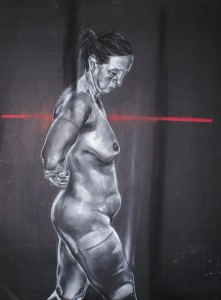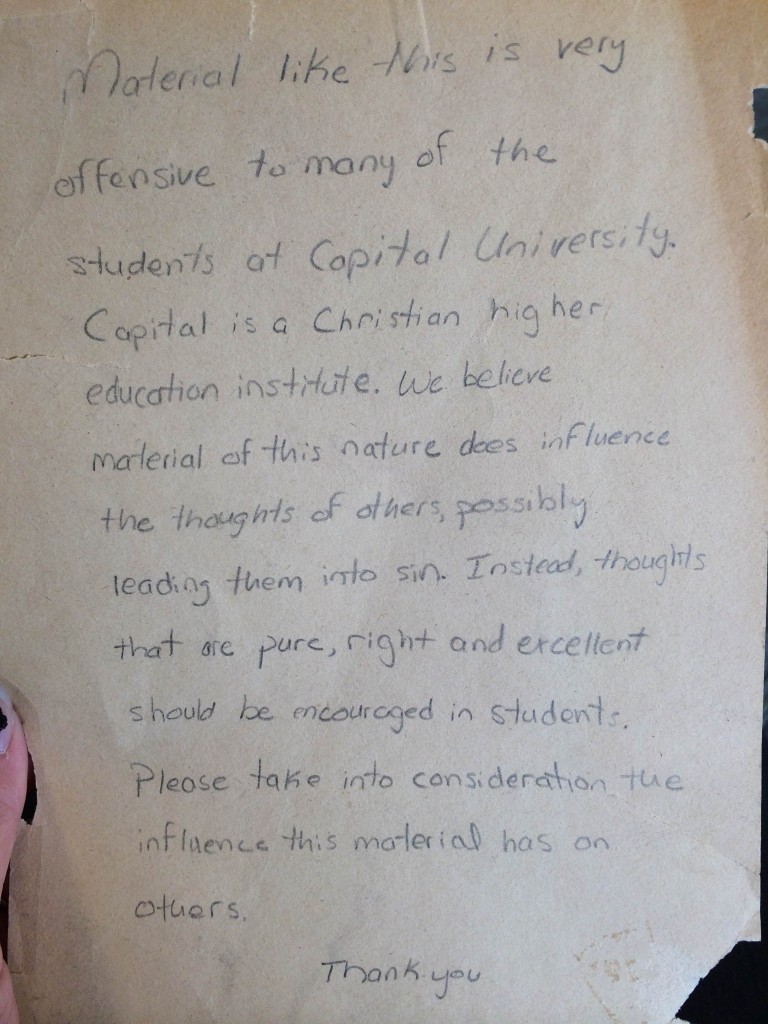Charcoal drawings by Rachael Schreiner
For being the most studied, well-known, and common breathing being on the planet, the natural human body in its stark nakedness is unwelcome in most public and even private settings, especially on display in works of art. Even Capital art students and professors have had discouraging experiences regarding nudity in their art.
Several ancient pieces of art that have been uncovered take the form of a nude human body, showing that the taboo of nudity has not been a constant since the beginning of human existence, but a cautious mindset that has been filtered in and out of time periods and cultures.
Jeff Shaw, studio art professor and adviser at Capital, is proud to teach a life drawing class that the department has offered for many years. Two or three nude models are hired to pose for a handful of sessions throughout the class each semester.
“It’s been a tradition in art since the beginning of time. It’s one of the most common themes,” Shaw said.
Many people, including senior nursing student Adrianna Reyna, wonder why the naked body, something that everyone is obviously familiar with, is considered taboo, negative, or sinful.
“I feel like nudity in art portrays real life, so it’s not a ‘bad thing,’” Reyna said. “The only time you ever see nudity anymore in media is when it’s sexualized and when it’s some young girl that the men ‘want’ to see, but art portrays the body in an artistic and spiritual way almost, like how the body truly is.”
The life drawing class, which is required for art majors, has received accolades from students as being a favorite among the art classes offered at Capital.
“Being in college and having nude models in classes should be totally OK,” Chris Fekete, senior art education major, said. “After all, we are adults and know what we look like naked. Having taken life drawing and drawing from life models, the overall awkwardness of staring at a naked person quickly subsides and you no longer think of it in a sexual way, but rather as a form to draw or paint. Through exposure the taboo and sexualization disappears.”
During his time at Capital as both a professor and student, Shaw has only experienced one reaction of negativity toward nudity in student artworks, and it was anonymous.
Before Shaw began teaching the class, long-time figure artist and professor Gary Ross was the instructor. Roughly 10-15 years ago, student life drawings were displayed on the artist bulletin boards in Huber-Spielman, and when he arrived to class one day the boards were empty with the exception of an anonymous note.
“Gary put the life drawings out in the hall like he did for many, many years, and one morning he came in and the pictures were all gone, and somebody had posted this note,” Shaw said.
The note reads, “Material like this is very offensive to many of the students at Capital University. Capital is a Christian higher education institute. We believe material of this nature does influence the thoughts of others, possibly leading them to sin. Instead, thoughts that are pure, right and excellent should be encouraged in students. Please take into consideration the influence this material has on others. Thank you.”
“They hid all the drawings, but he eventually found them,” Shaw said.
In high school, Jenna Kreider, a senior art therapy major, chose to do a series of life drawings for her senior project that was expected to hang on display in a local museum.
“Imagine my surprise when I went to the show and I was the only senior who didn’t have art in the show because ‘kids go there,’” Kreider said. “I feel like leaving nude models out of college classrooms is leaving out a whole section of curriculum.”
But why is the naked body such a popular subject for artworks?
“First of all, it’s a natural thing to begin with, but it’s the perfect subject to draw,” Shaw said. “It has all kinds of different forms, lights and darks. It has bone structure, which is angular, and it’s got flesh that’s smooth and curvy, and it’s just perfect. It’s humanity, and it’s people.”
And why must the body be naked? What’s the problem with wearing clothes?
“Some people wonder why they don’t wear clothes, and sometimes they do, but it separates the body into pieces and you don’t see or draw it as an uninterrupted form,” Shaw said.
While some outsiders may wonder what the benefit of a nude model is, it is rarely questioned by art students themselves.
“Having a live model in front of you can at first be a little scary, but when you begin to see the body as curved lines and shades of color, your relationship with the subject changes dramatically,” Carolann Dye, senior studio art major and digital design minor, said. “The naked body has been, and always will be, linked to a sexual nature so I create each portrait knowing that there will be at least one person who is offended. However, I hope that one person can try to see the beauty in the bare body. I sure do.”
Modeling for artists could be considered an art in itself.
“I get phone calls constantly from people who want to model here,” Shaw said. “It’s hard work. When people model for artists they model for three or four hours or longer. They can take breaks, but then they have to get back in the exact same position. It’s physically difficult, and it has to be somebody who’s at home with their body.”
Female models often tell Shaw that modeling makes them feel comfortable, empowered, and beautiful in their own bodies. The pay rate for modeling gigs usually begins at $20 an hour. Overall, it sounds like a win/win for both the artist and the model.
No two human bodies are the exact same, making each body on earth individually unique, fascinating, and captivating – only one reason why the body is considered a true work of art.




